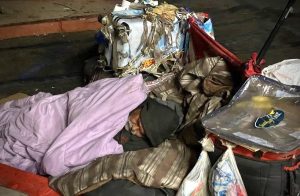As the abandoned building in downtown Calexico was being burned down to the ground, sitting motionless in one corner near the burning structure was the 60-year-old homeless George Ocampo, oblivious to the danger.
While local firefighters tried to contain the smoke, the bystanders watching the fire were repeating the political trend that homeless people were responsible for three massive fires in March and April, two in downtown and one on the city’s east side.
“It’s the homeless that are responsible for this,” one person was overheard saying.
“The city is letting these people camp everywhere and allowing this to happen,” another one said.
Unhoused but not family-less
Like most unhoused people, Ocampo likes to pick a “comfortable and secure” space to sleep. If no one bothers him, he could spend entire days in the same location regardless if the weather is hot, cold, or windy.
These days, he sleeps on a concrete floor of a street located on the corner of Heffernan and Second Street in the downtown area of Calexico, a US-Mexico border city in California’s Imperial Valley County. In the past, one particular bus stop was his spot for months before the police asked him to leave, which started a period of moving to different places in downtown.
“Sometimes you see bad looks from the cops but that’s the way it is,” Ocampo said.
Though unhoused, Ocampo is not family-less. Alone and with several bags of clothes next to him, Ocampo spends his days alone remembering his past and the large family he used to have: seven children, of whom three daughters are in Mexicali and two sons reside in Texas.
“I’m waiting for my check from the disability they owe me. I think they need to pay me $3,000 and the director can’t even give me $1,000 and I’m also waiting for Ms. Ramirez from the convalescent home in El Centro, California,” Ocampo said when asked why he was staying in the streets.
“I had a place to stay before with the ex-woman. It hurts your feet to stay here but at least I have a place to sleep on the corner of this street, thank God,” he added. “I thank the lord that I have a place to lay down. There is nothing to be proud of to be homeless, it’s very difficult, it’s a temporary necessity.”
Downtown in downturn
Once prosperous as an international port of entry between the US and Mexico, Calexico is currently economically depressed. The city government has been mired in budget deficits for over a decade and its downtown is peppered with many empty buildings and closed stores.
Like other blighted cities, the downtown is attracting an increasing number of transients and their encampments. Posing as an eyesore with no solutions in sight, the homeless, particularly those with mental issues, are perceived by many Calexico residents as pests, dirt, and even a safety issue.
Gradually, a hatred towards the homeless people in downtown Calexico got fermented and the persistent economic depression has also turned them into a convenient scapegoat for all of the city’s problems.
As the topic has become so toxic, everyone and any program that provides any kind of support to the homeless population – including the volunteers and city food program that help feed the street people, and the city parks where there are encampments – are all blamed for the rising number of homeless people, who are siphoning off the already low resources thus contributing to the decline of Calexico’s economy.
The invisible people
Like Camacho, Elesban Sanchez is also an unhoused loner. After walking away from his family, he has survived by himself with no support from anyone for more than 20 years. He admits that he is difficult to deal with and would rather stay alone than hurt someone.
“I walked away from my parents, children, and my family. They went their ways and I took mine,” he said.
“My children don’t remember me as I was not part of their lives,” Sanchez said when asked to share something about his life. “I don’t have anyone to rely on.”
At 74, Sanchez, who encamps next to the railroad tracks on the west side of Calexico, is actually physically strong. He likes to move around town. For people who have noticed him, he is often seen taking public transit and staying at different places carrying a bag of clothes he changes. Though his clothes are not washed, they are his prized possession.
In this valley’s desert, where temperatures reach 120 degrees, Sanchez just needs a small shady spot somewhere downtown, outside of the sun’s scorching ray.
Sanchez is not a panhandler. To sustain himself, he has been working in the fields. However, at his advanced age, he finds it increasingly difficult to get selected for farm work.
“I’m getting old and I probably won’t be able to work that much anymore,” he said. The little money he gets is to buy food and continue to survive.
Economics of a humanitarian crisis
California has one of the highest rates of homelessness in the United States. According to the California Budget and Policy Center, 171,000 Californians were counted as experiencing homelessness in early 2022. This number includes individuals living on the street, in shelters, or in other temporary housing situations.
According to the Imperial County Homeless Strategy Plan, there are 1,225 unsheltered households living on the streets, in cars, or in places not meant for human habitation and 188 sheltered families staying in emergency shelters and transitional housing programs. These numbers represent a 47 percent increase in the county since 2017.
This large spike can also be attributed, in part, to better counting practices. In 2019, roughly 190 volunteers were deployed to count unhoused people in inner cities within Imperial County.
Economically, a chronically homeless person on the streets can cost county taxpayers an average of $35,578 per year. But when a homeless person is placed in supportive housing, which costs on average $12,800 annually, the reduction in care expenses such as food and medical services would cut the total cost by an estimated 49.5%.
When it comes to the deployment of emergency services, jail costs are estimated at $83.82 per day/per individual, averaging an annual cost of $2.5 million, not including facility operating costs.
Hospitals “write off” $13.4 million per year as the cost of people using emergency rooms and medical/hospital services; fire response in encampments.
The target of hate and vulnerable victims
Constantly facing extreme weather, inhumane living conditions, and street dangers, these unhoused people have bad hygiene and are dressed in dirty clothes. Medical attention and social interactions are also non-existent.
It takes kindness and a set of humanitarian eyes to see and recognize the existence of unhoused people like Camacho and Sanchez.
Against this lack of empathy, a disconnect with people who live on the social margins, unhoused people have become a target of hate for many Calexico residents.
According to the Imperial Valley’s Sure Helpline Center (SHC), which provides social services for women (including unhoused individuals) and families experiencing a domestic crisis, since January of this year, of the approximately 40 homeless people who came to center requesting help, 15 have reported some types of hate crimes and incidents, including sexual violence.
“Some of them are victims of robbery and they lose their I.D. and social security cards so we help them on that,” said Johana Ramirez, Lead Advocate at SHC. Located near the bus station where many unhoused people congregate, the center helps these individuals find shelters and other resources such as mental health and drug addiction treatments.
Ramirez said that many hate cases of abuse often go unreported due to fears of retribution since most of the perpetrators are also within the same circles of people they deal with out on the streets every day.
Unhoused people carry dirty clothes, have bad hygiene, live in unsafe and decrepit settings, and often exude ill social manners. But they are also human beings with unique life stories. In Calexico, they have become a political scapegoat and a target of hate as the city continues to struggle with its economic recovery.






